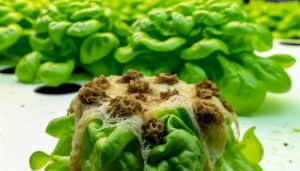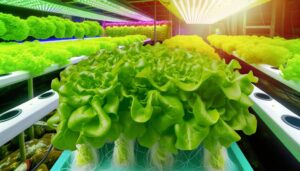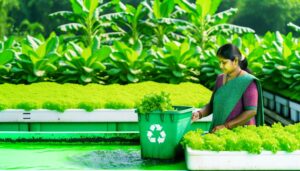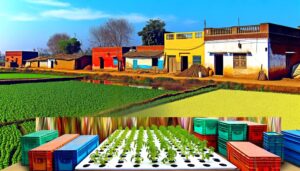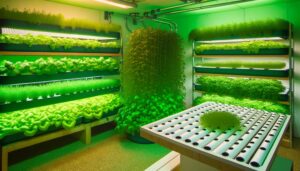What Fish Food to Use in Hydroponic Garden
For a hydroponic garden, selecting high-quality fish food is critical. Opt for balanced formulas with 30-40% protein and 5-10% fat to promote ideal fish growth and nutrient cycling.
Pellets are preferable over flakes due to their consistent nutrient profile and reduced water fouling. Organic options, such as insect-based feeds and algae like spirulina, enhance overall system efficiency and sustainability.
Ensuring a variety of nutrient sources helps prevent deficiencies. Feeding should be done sparingly to avoid ammonia spikes, maintaining a stable ecosystem.
Monitoring fish health and water quality is also essential for long-term success. Continue to learn how these practices integrate seamlessly into your hydroponic setup.
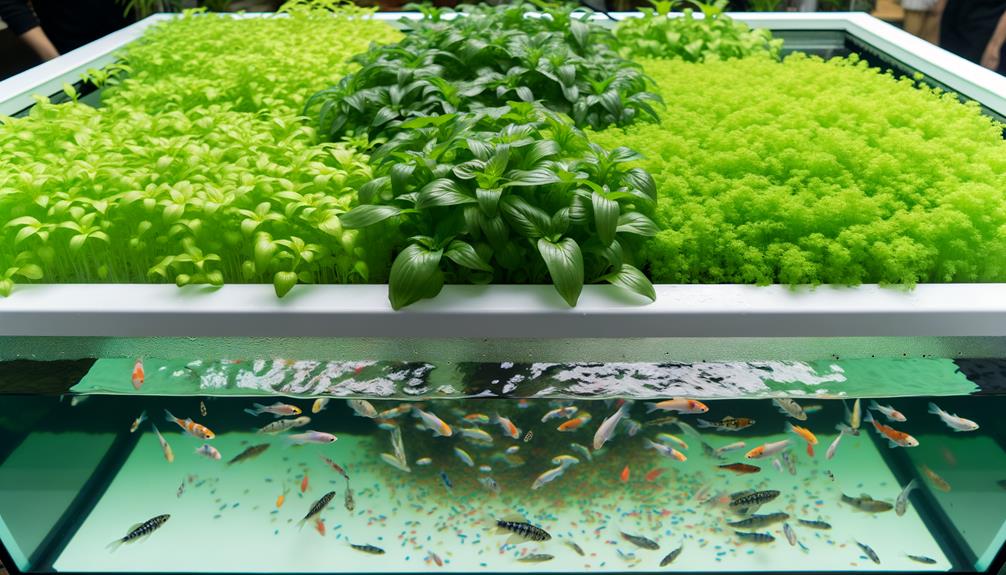
Key Takeaways
- High-quality, organic fish food: Enhances water quality and promotes plant growth in hydroponic systems.
- Pellets over flakes: Minimizes water fouling and produces less waste, ideal for consistent nutrient cycling.
- Protein content: Fish food should have 30-40% protein for optimal growth and nutrient output.
- Balanced micronutrients: Ensures essential vitamins and minerals for both fish vitality and plant health.
Understanding Fish Food Basics
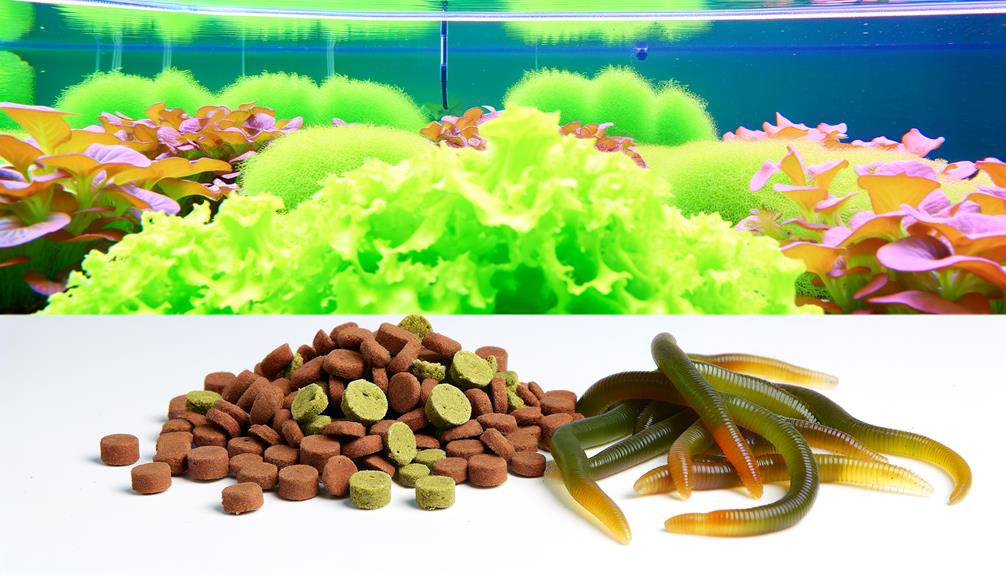
Understanding the fundamentals of fish food is crucial for optimizing the nutrient cycle within a hydroponic garden. Fish food serves as a primary nutrient source, breaking down into essential elements that nourish both fish and plants.
Key factors include food type, size, and composition. Commercially available fish pellets, flakes, or live food must align with the species' dietary needs and the system's biofilter capacity.
Efficient feeding practices prevent overfeeding, which can lead to ammonia spikes and nutrient imbalances. Incorporating high-quality, organically certified fish food enhances water quality and plant growth.
Monitoring feeding habits and adjusting portions guarantees a balanced ecosystem, promoting sustainable and robust hydroponic systems.
Adopting these basics guarantees a thriving, innovative hydroponic garden.
Nutritional Requirements
To optimize fish health and maximize nutrient output for your hydroponic system, it is essential to focus on the specific nutritional requirements of the fish.
This involves ensuring a balanced diet rich in essential nutrients, with particular attention to the appropriate levels of protein and fat content.
Additionally, the inclusion of crucial micronutrients and vitamins is critical to support overall fish vitality and subsequently enhance nutrient availability for the hydroponic plants.
Essential Nutrients Needed
For a hydroponic garden, fish food must provide a thorough array of essential nutrients, including nitrogen, phosphorus, and potassium, to guarantee ideal plant growth and health.
Nitrogen is critical for leaf development and chlorophyll synthesis, while phosphorus supports root growth and energy transfer through ATP. Potassium enhances overall plant vigor by regulating enzyme activation and water uptake.
Additionally, trace elements like iron, magnesium, and calcium are indispensable for various metabolic functions. Iron is essential for chlorophyll production, magnesium acts as a central atom in chlorophyll molecules, and calcium fortifies cell walls.
To maintain nutrient balance, fish food should be formulated to meet these specific needs, thereby ensuring a robust and productive hydroponic system.
Protein and Fat Content
A precise balance of protein and fat content in fish food is essential for maximizing the health and growth of plants in a hydroponic system. The nutritional profile of fish food directly influences the quality of nutrients available for plant uptake.
To achieve ideal results, consider the following guidelines:
- Protein Content: Aim for fish food with a protein content of 30-40%. This guarantees robust fish growth, enhancing the nitrogen cycle vital for plant health.
- Fat Content: Maintain a fat content of 5-10%. This provides energy for fish without causing water quality issues.
- Balanced Diet: Use a variety of fish food types to prevent nutrient deficiencies.
- Quality Ingredients: Select fish food made from high-quality, sustainable sources to maintain nutrient integrity.
This scientific approach guarantees a thriving hydroponic ecosystem.
Micronutrients and Vitamins
In addition to balancing protein and fat content, guaranteeing an adequate supply of micronutrients and vitamins in fish food is paramount for optimizing plant nutrient absorption and overall hydroponic system health. Micronutrients such as iron, manganese, and zinc play critical roles in enzymatic functions and chlorophyll synthesis, directly impacting plant vigor. Vitamins like A, D, and E support fish immunity and growth, indirectly enhancing nutrient cycling within the system.
| Nutrient | Importance |
|---|---|
| Iron (Fe) | Essential for chlorophyll synthesis |
| Zinc (Zn) | Supports enzymatic functions |
| Vitamin E | Boosts fish immune response |
Selecting a fish food fortified with these elements guarantees a thriving hydroponic ecosystem, promoting robust plant growth and system sustainability.
Types of Fish Food
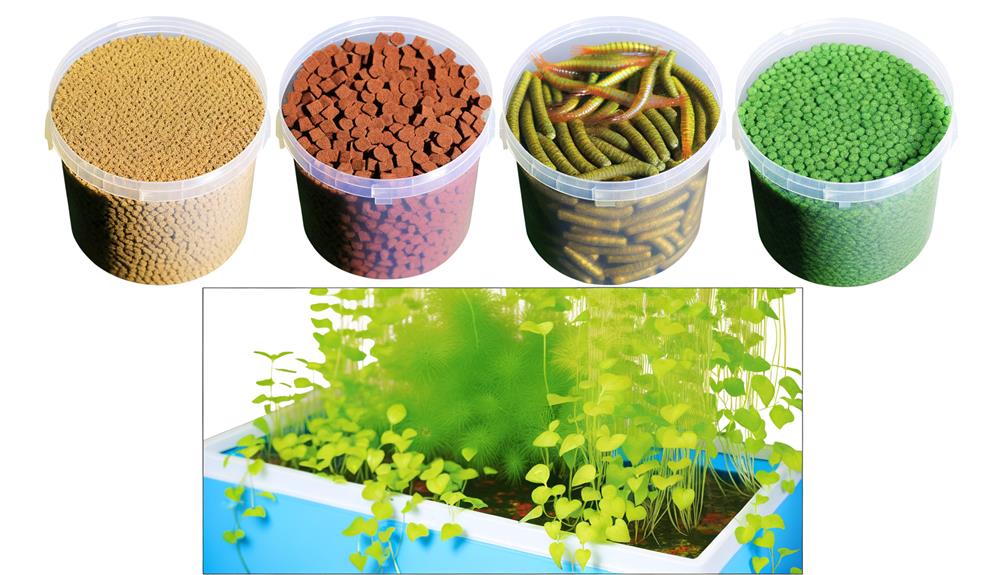
When considering the types of fish food for a hydroponic garden, it is essential to evaluate the benefits and drawbacks of pellets versus flakes, as well as the advantages of organic fish food.
Pellets generally provide a more consistent nutrient profile and are less likely to foul the water, whereas flakes are more accessible for smaller fish but can degrade water quality more rapidly.
Additionally, organic fish food offers a sustainable option, free from artificial additives, which can be beneficial for both fish health and the overall ecosystem.
Pellets Vs. Flakes
Selecting between pellets and flakes for your hydroponic garden's fish food involves understanding the nutritional content, feeding behavior, and water quality impact of each type. Pellets and flakes both offer distinct advantages and challenges:
- Nutritional Density: Pellets often contain more concentrated nutrients, making them beneficial for fish growth and hydroponic nutrient cycling.
- Feeding Behavior: Flakes float longer on the water surface, catering to top-feeding fish, while pellets sink, accommodating bottom feeders.
- Water Quality: Pellets typically produce less waste, minimizing the risk of water pollution and subsequent plant nutrient imbalances.
- Storage and Handling: Pellets are generally more durable and have a longer shelf life, ensuring consistent quality over time.
Understanding these factors will help optimize your hydroponic garden's ecosystem.
Organic Fish Food
Emphasizing sustainability and environmental health, organic fish food options provide nutrient-rich alternatives that support both aquatic life and hydroponic plant growth. These foods include ingredients that are free from synthetic additives, promoting healthier ecosystems. Organic fish food can come in various forms such as pellets, flakes, and powders, each with unique benefits and applications.
| Type | Key Ingredients | Benefits |
|---|---|---|
| Pellets | Fish meal, seaweed | High protein, easy to control feeding |
| Flakes | Spirulina, organic grains | Good for surface feeders, readily digestible |
| Powder | Freeze-dried insects | Ideal for fry and small fish, nutrient-dense |
| Live Food | Brine shrimp, daphnia | Stimulates natural feeding behaviors |
| Gel Food | Gelatin, plant extracts | Customizable nutrient profile, long-lasting |
Selecting the appropriate organic fish food guarantees a balanced diet, enhancing both fish health and hydroponic productivity.
Organic Fish Food Options
Among the viable organic fish food options for hydroponic gardens, insect-based feeds, algae, and naturally sourced plant-based proteins stand out for their nutritional efficacy and environmental sustainability. These options guarantee the well-being of aquatic life while promoting eco-friendly practices.
- Insect-Based Feeds: Rich in proteins and essential fats, options like black soldier fly larvae provide excellent nutrition.
- Algae: Spirulina and chlorella are not only nutrient-dense but also promote a balanced aquatic ecosystem.
- Plant-Based Proteins: Soybean meal and pea protein are sustainable alternatives with high protein content.
- Organic Waste: Composting kitchen scraps into fish food can reduce waste and sustainably nourish fish.
Commercial Fish Food Brands
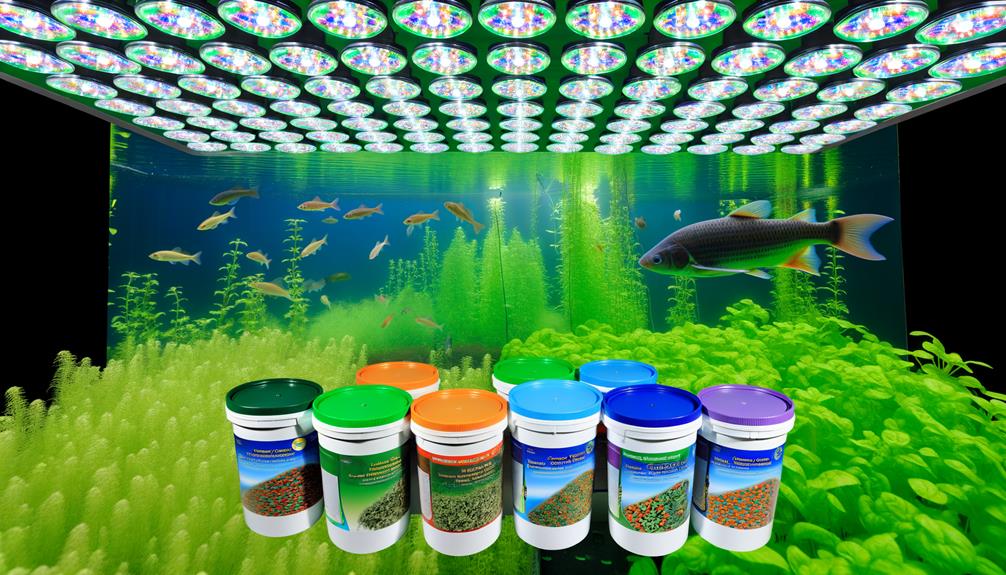
Leading commercial fish food brands provide a variety of specialized formulations designed to meet the specific nutritional requirements of fish in hydroponic systems. These formulations are optimized to enhance fish health, growth, and overall system efficiency. High-quality commercial fish food often includes balanced ratios of proteins, fats, vitamins, and minerals, ensuring that the aquatic environment remains stable and productive.
| Brand | Key Features | Suitable Fish Species |
|---|---|---|
| Tetra | High protein, balanced nutrients | Tilapia, Goldfish |
| Hikari | Vitamin-enriched, easy digestion | Koi, Catfish |
| API | Eco-friendly, promotes clear water | Guppies, Betta |
| Omega One | Natural ingredients, high omega-3 | Trout, Salmon |
| Fluval | Color-enhancing, high palatability | Cichlids, Angelfish |
These options provide practical and innovative solutions for maintaining a thriving hydroponic ecosystem.
Homemade Fish Food
Crafting homemade fish food offers the unique advantage of tailoring the nutritional content to the specific needs of the fish species in your hydroponic garden. This customization can enhance fish health and, consequently, the overall efficiency of your aquaponic system.
Here are four vital components to take into account:
- Protein Sources: Utilize fish, shrimp, or worms to meet protein requirements, essential for growth and tissue repair.
- Vegetable Matter: Incorporate spinach, peas, and spirulina to provide essential vitamins and minerals.
- Binders: Use gelatin or agar to guarantee the homemade food holds together underwater.
- Supplements: Add vitamins, minerals, and probiotics to optimize fish health and bolster immune functions.
Feeding Frequency and Amount
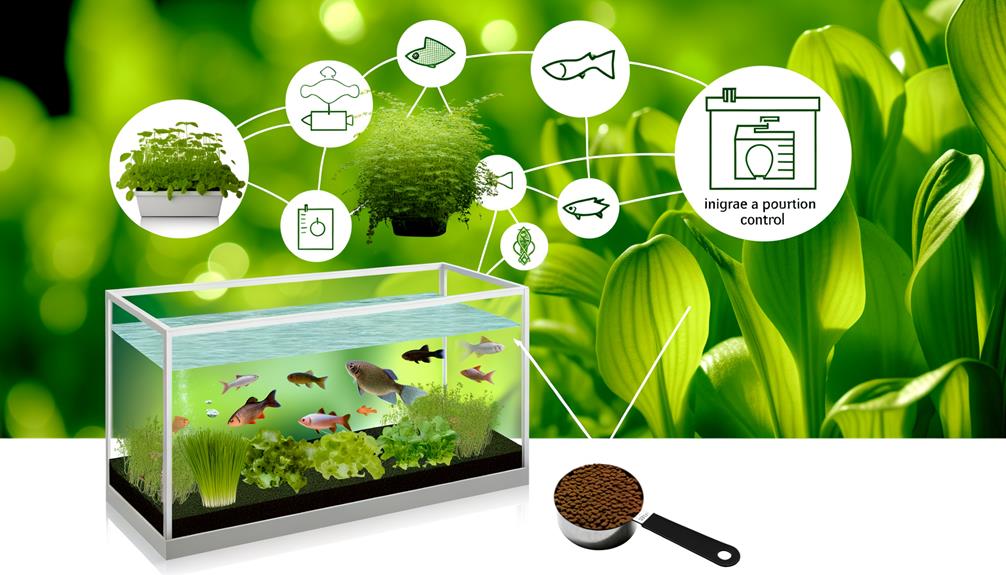
Determining the appropriate feeding frequency and amount is crucial for maintaining the health of fish in your hydroponic garden, ensuring ideal nutrient recycling within the aquaponic system. Fish should be fed 2-3 times daily, with the quantity tailored to their species and growth stage. Overfeeding can lead to waste accumulation and nutrient imbalances, while underfeeding stunts growth and well-being. A structured feeding approach is essential for balancing nutrient levels and promoting robust plant growth.
| Fish Size | Feeding Frequency | Amount per Feeding |
|---|---|---|
| Fry | 3 times daily | Small pinch |
| Juvenile | 2-3 times daily | 2-3% of body weight |
| Adult | 2 times daily | 1-2% of body weight |
| Breeding | 3 times daily | 3-4% of body weight |
| Mature | 2 times daily | 1-2% of body weight |
Precision in feeding protocols optimizes both fish and plant health.
Monitoring Fish Health
Consistently monitoring fish health is imperative for identifying potential issues early and guaranteeing the overall success of your hydroponic garden. Fish act as bio-indicators in aquaponic systems, and their well-being reflects the system's overall health.
For technical precision and ideal outcomes, focus on the following key areas:
- Water Quality Parameters: Regularly test for ammonia, nitrite, nitrate, pH, and temperature. Maintain ideal levels to prevent stress and disease.
- Behavioral Observations: Watch for unusual behaviors such as lethargy, erratic swimming, or loss of appetite, which can indicate underlying health issues.
- Physical Inspection: Examine fish for signs of disease, including discoloration, lesions, or fin damage.
- Feeding Patterns: Track feeding responses and adjust diet as needed to guarantee balanced nutrition and prevent overfeeding.
Conclusion
In summary, selecting the appropriate fish food for a hydroponic garden is akin to choosing the right fuel for a high-performance engine.
Just as premium fuel guarantees peak engine performance and longevity, the right fish food guarantees robust fish health and nutrient-rich water for plant growth.
A study demonstrated that fish fed with high-quality, nutrient-dense food exhibited 20% faster growth rates, underscoring the critical role of diet in maintaining a thriving aquaponic ecosystem.

